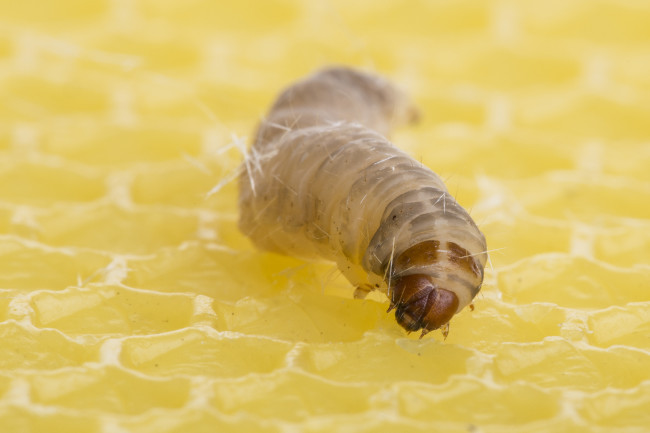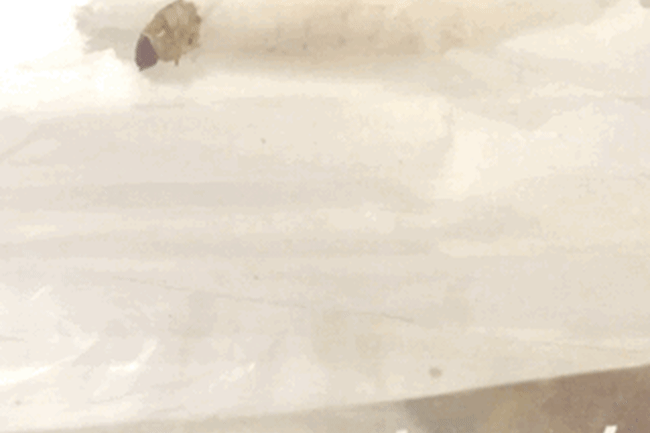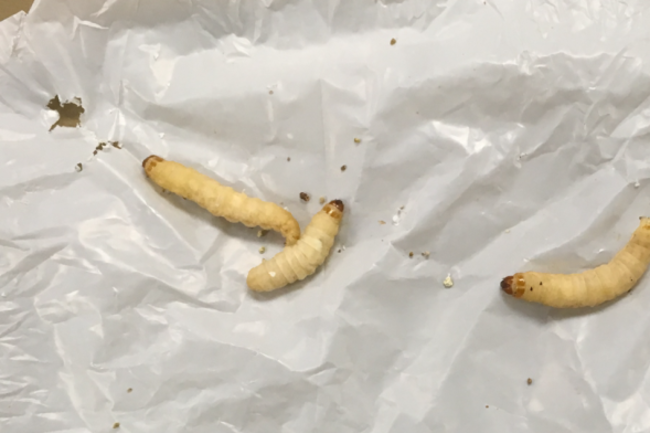Discover the 2-in-1 'plastic feeding machine': the caterpillar and its gut bacteria easily digest the most persistent plastic
Each year, people release about 300 million tons of plastic into the environment, transporting them everywhere and dumping in a landfill; most likely the plastic you threw away years ago is still around somewhere on this tiny Earth. Things start to get worse, as the plastic breaks down into microscopic plastic - tiny plastic particles begin to creep into the water, spilling out into the sea, finding a way to get into our bodies. Humans have yet to find a way to handle plastics effectively.
But maybe Mother Nature kept the answer to that burning problem. Scientists have discovered that caterpillars are interested in eating this persistent waste. While they can't eat off the garbage we have, the secrets that lie in the caterpillar's stomach can help us solve a difficult problem.

' Nature has given us a wonderful starting point, showing us how to decompose plastic by natural means, ' said biologist and new study author Christophe LeMoine at Brandon University. " But we still have to solve a few problems before we can apply this technology, it's best to minimize the use of plastic until the problem is resolved ."
Many localities have applied laws to limit plastic waste, many large corporations are determined to reduce plastic in production, many households have better understand the harmful effects of plastic to the environment. But plastic recycling is still difficult. Even if we cut that indigestible garbage, there are tons of plastic still on the ground and in the water.
In nature, there exists a group of organisms called by science called 'plastivore'. These organisms are capable of digesting the common plastics, and researchers have identified about 50 species that feed on plastic, from bacteria, fungi to caterpillars. Recently, we have discovered a few more insects that are able to turn polyethylene - the second most difficult plastic to break down - into energy.

Professor LeMoine and colleagues focused on the insect they consider to be the most potential: the greater wax moth larva. These caterpillars take advantage of bacteria in the gut to break down and convert plastic into energy. The scientists isolated the bacterium and tried growing it in a laboratory, and found it could live all year without eating plastic.
But that bacterium is not the only creature that helps the caterpillar eat the plastic; The team discovered the ' incredibly close relationship ' between caterpillars and the bacteria in their gut: both organisms can ingest plastic. When the 'dual swords match flanges', they digest the plastic at a remarkably fast pace.
These moths are also not mutants that appear when the environment has too much plastic waste. Previously, they were creatures that destroyed the bee farm, specialized in attacking hives and living on beeswax, molting by-products of bee larvae, pollen and honey.
For humans, plastic and beeswax are unrelated concepts, but with the larvae of large wax butterflies, plastic is just as nutritious as wax. Research shows that the structure of beeswax consists of long chains of carbon and hydrogen - molecules called hydrocarbons. That is also the composition of plastic.

' The wax butterfly larvae and bacteria in the gut must break down the hydrocarbon structure in order to obtain nutrition, ' says Professor LeMoine. ' And assuming that, because the plastic has a similar structure, the moths can use this method of absorbing beeswax to break down the plastic, creating nutrition .' Research has shown that there are bacteria that prefer to live on plastic rather than beeswax.
But the existence of this bacterium does not mean releasing billions of bacteria to eat less plastic. What is remarkable is that the plastic breakdown mechanism allows the caterpillars and bacteria in their intestines to obtain nutrients. Through them, we can find effective plastic suppression technology.
The journey may be far, but any way is like that, just keep going.
Refer to DiscoverMag
You should read it
- Science created a shocking red-eye mutant bee
- 530 million year old fossils have eyes like bees, dragonflies today
- The number of honey bees in the world decreased by nearly 12%
- New research: audible flowers and the flapping of bee wings make honey more sweet
- Bioplastic biodegradable in natural environment made from shrimp shells
- Climate change puts bees at risk of extinction, but it's not too late for humanity to save them and save themselves
- The small animal terrified the giant elephant to flee
- Can Bee Bee Bee be pollinating flowers?
May be interested
- Things to know when using food plastic
 with low price, durable many people often choose plastic box to use. but plastic boxes, when stored improperly, pose a great risk to health. therefore, when using plastic, you should note the following.
with low price, durable many people often choose plastic box to use. but plastic boxes, when stored improperly, pose a great risk to health. therefore, when using plastic, you should note the following. - Discover new fungi joining hands with bacteria that cause Crohn's disease
 researchers from case western reserve university have announced the discovery of a new fungus that is dangerous to join two bacteria that cause crohn's disease in patients.
researchers from case western reserve university have announced the discovery of a new fungus that is dangerous to join two bacteria that cause crohn's disease in patients. - The world of microbes shimmering and fantasy on your teeth
 human mouth is the place that contains the most bacteria, especially in plaque. they are always obsessions for each person. but the beautiful close-up photos below will surprise you and have a new perspective on the world of bacteria on your teeth.
human mouth is the place that contains the most bacteria, especially in plaque. they are always obsessions for each person. but the beautiful close-up photos below will surprise you and have a new perspective on the world of bacteria on your teeth. - How are people using plastic to destroy nature?
 the images taken in nature below will show us the tremendous devastation of plastic waste to the environment and the animals.
the images taken in nature below will show us the tremendous devastation of plastic waste to the environment and the animals. - What do the symbols at the bottom of plastic bottles mean?
 in the article below, network administrator will help you answer the symbols at the bottom of plastic bottles for you to choose when using.
in the article below, network administrator will help you answer the symbols at the bottom of plastic bottles for you to choose when using. - The Earth has more than 8 billion tons of plastic, weighing about 1 billion elephants
 from 1950 to 2015, in just over six decades, the world produced more than 8.3 billion tons of plastic, a total weight of 25,000 empire state buildings, 381m high in the us or 1 billion elephants.
from 1950 to 2015, in just over six decades, the world produced more than 8.3 billion tons of plastic, a total weight of 25,000 empire state buildings, 381m high in the us or 1 billion elephants. - It is not difficult to remove unpleasant odors in the washing machine
 after a long time of use, you discover your washing machine suddenly has a bad smell. if you continue to use it, this smell will haunt your clothes. you are struggling to handle how you can do it in a way ...
after a long time of use, you discover your washing machine suddenly has a bad smell. if you continue to use it, this smell will haunt your clothes. you are struggling to handle how you can do it in a way ... - Get fever with new technology to identify E-coli bacteria
 this is considered to be the most optimal biotechnology device that begins to have a display of violation, identifying bacteria in water for the purpose of protecting human health.
this is considered to be the most optimal biotechnology device that begins to have a display of violation, identifying bacteria in water for the purpose of protecting human health. - The towel is the ideal environment for bacteria to grow
 in addition to toilets, living rooms, kitchens. are places that contain the most bacteria, face towels are also a paradise for bacteria to grow. towels are a familiar and essential item of most of us in life.
in addition to toilets, living rooms, kitchens. are places that contain the most bacteria, face towels are also a paradise for bacteria to grow. towels are a familiar and essential item of most of us in life. - 'Round the eyes' with 21 innovative ways to recycle old plastic bottles
 to enhance your dexterity and creativity, on the bright side page has given you 21 super unique ideas on how to recycle old plastic bottles into extremely useful items. invite you to consult!
to enhance your dexterity and creativity, on the bright side page has given you 21 super unique ideas on how to recycle old plastic bottles into extremely useful items. invite you to consult!










 Scientists have finally discovered the mystery of dark matter in the universe
Scientists have finally discovered the mystery of dark matter in the universe Leaving the Avengers aside, these are the 10 most powerful animals in the Marvel universe
Leaving the Avengers aside, these are the 10 most powerful animals in the Marvel universe Future threat: AI not only takes away human jobs, it also directly prevents workers from looking for work
Future threat: AI not only takes away human jobs, it also directly prevents workers from looking for work Why do insects abandon their large prehistoric bodies and become smaller and smaller?
Why do insects abandon their large prehistoric bodies and become smaller and smaller? The tattered frescoed hut in San Francisco is for sale for $ 2 million
The tattered frescoed hut in San Francisco is for sale for $ 2 million The MIT team claims to find the most effective way of 'intercepting' meteorites
The MIT team claims to find the most effective way of 'intercepting' meteorites